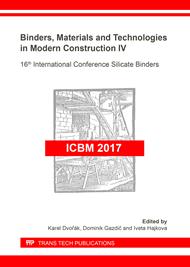[1]
J. Bharj, S. Singh, S. Chander, R. Singh, Experimental study on compressive strength of cement-CNT composite oaste, Indian Journal of pure and applied Physics. 52 (2014) 35-38.
Google Scholar
[2]
A. Sanchez, K. Sobolev, Nanotechnology in concrete – a review, Construction and building materials. 24 (2010) 2060-2071.
DOI: 10.1016/j.conbuildmat.2010.03.014
Google Scholar
[3]
M. Eftekhari, S. Mohammadi, Molecular dynamics simulation of nonlinear behavior of the CNT-reinforced calcium silicate hydrate (C-S-H) composite,. Composites: Part A. 82 (2016) 78-87. http://dx.doi.org/10.1016/j.compositesa.2015.11.039.
DOI: 10.1016/j.compositesa.2015.11.039
Google Scholar
[4]
S. Paptzani, K. Paine, J. Calabria-Holley, A comprehensive review of the models on the nanostructure of calcium silicate hydrates. Construction and building materials. 74 (2015) 219-234. URL: http://dx.doi.org/10.1016/j.conbuildmat.2014.10.029.
DOI: 10.1016/j.conbuildmat.2014.10.029
Google Scholar
[5]
S.J. Murray, V.J. Subramani, R.P. Selvam, K.D. Hall, Molecular dynamics to understand the mechanical behavior of cement paste. Trans Res Rec: J Transport Res Board 2142(1) (2010) 75–82.
DOI: 10.3141/2142-11
Google Scholar
[6]
А.F. Khuzin, М.G. Gabidullin, R.Z. Rakhimov, А.N. Gabidullina, О.V. Stoyanov, Modification of cement composites with carbon nanotubes. The reporter of KTU. 16/5 (2013) 115-118.
Google Scholar
[7]
B. Нan, S. Sun, S. Ding, L. Zhang, X. Yu, J. Ou, Reiew of nanocarbon-engineered multifunctionl cementitious composites. Composites: Part A. 70 (2015) 69-81. http://dx.doi.org/10.1016/j.compositesa.2014.12.002.
DOI: 10.1016/j.compositesa.2014.12.002
Google Scholar
[8]
О.Yu. Sheida, E.I. Batyanovsky, The effect of complex chemical additive, containing structured carbon nanomaterial, on the properties of cement. Science and engineering. 2 (2015) 31-38.
Google Scholar
[9]
V.I. Kalashnikov, Concrete: macro-, micro-, nano- and pico-scaled raw elements. Real concrete nanotechnologies, A book of conference reports «Days of modern concrete», Zaporozhye (2012) 38–50.
Google Scholar
[10]
Е.V. Korolyov, Principles of nanotechnology implementation in constructional materials engineering. Construction and building materials. 6 (2013) 60-64.
Google Scholar
[11]
Yu.D. Tretyakov, Self-organization processes in material chemistry, Chemistry Achievements. 72 (8) (2003) 731-758.
Google Scholar
[12]
А.V. Ilyukhin, V.I. Marsvo, М.А. Astafyev, V.S. Seleznev, Description of matrix structures of composite material. Automation and management in technical systems. 2 (2015) 181 – 190.
Google Scholar
[13]
V.I. Solomatov, The development of polystructural theory of constructional composite materials. Higher educational institutions proceedings: Construction. 8 (1985) 58-64.
Google Scholar
[14]
V.I. Solomatov, А.I. Bobryshev, К.G. Khimller, Polymer composite materials in construction, Stroyizdat, Moscow, 1988., 308 p.
Google Scholar
[15]
V.N. Kozomazov, The structure and properties of high-filled constructional polymer composites, Abstract of PhD thesis, Moscow, 1997., 44 p.
Google Scholar
[16]
V.A. Lotov, Nanodispersed systems in technology of building materials and units. Bulletin of the Tomsk Polytechnic University. 311/3 (2007) 84-88.
Google Scholar
[17]
М.S. Garkavi, S.А. Nekrasova, Е.А. Troshkina, Kinetics of contact formation in nano-modifies gypsum mateials. Construction and building materials. №2 (2013) 38-40.
Google Scholar


